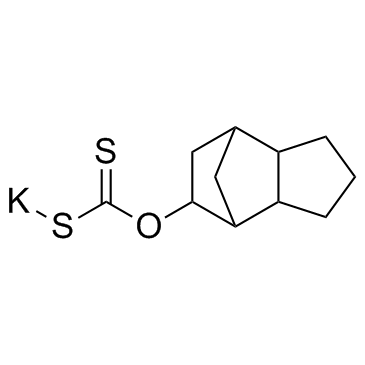D609

D609 structure
|
Common Name | D609 | ||
|---|---|---|---|---|
| CAS Number | 83373-60-8 | Molecular Weight | 266.465 | |
| Density | 1.24 g/cm3 | Boiling Point | 303.8ºC at 760 mmHg | |
| Molecular Formula | C11H15KOS2 | Melting Point | N/A | |
| MSDS | Chinese USA | Flash Point | 137.5ºC | |
| Symbol |

GHS07 |
Signal Word | Warning | |
|
Curcumin induces apoptosis of multidrug-resistant human leukemia HL60 cells by complex pathways leading to ceramide accumulation.
Biochim. Biophys. Acta 1841(12) , 1672-82, (2015) Most anti-cancer agents induce apoptosis, however, a development of multidrug resistance in cancer cells and defects in apoptosis contribute often to treatment failure. Here, the mechanism of curcumin-induced apoptosis was investigated in human leukemia HL60 ... |
|
|
Mycobacterium abscessus phospholipase C expression is induced during coculture within amoebae and enhances M. abscessus virulence in mice.
Infect. Immun. 83(2) , 780-91, (2015) Mycobacterium abscessus is a pathogenic, rapidly growing mycobacterium involved in pulmonary and cutaneo-mucous infections worldwide, to which cystic fibrosis patients are exquisitely susceptible. The analysis of the genome sequence of M. abscessus showed tha... |
|
|
Oxidative Stress Increases Surface Toll-Like Receptor 4 Expression in Murine Macrophages Via Ceramide Generation.
Shock 44 , 157-65, (2015) Multiorgan failure is a major cause of late mortality following trauma. Oxidative stress generated during shock/resuscitation contributes to tissue injury by priming the immune system for an exaggerated response to subsequent inflammatory stimuli, such as lip... |
|
|
Francisella tularensis LVS induction of prostaglandin biosynthesis by infected macrophages requires specific host phospholipases and lipid phosphatases.
Infect. Immun. 82(8) , 3299-311, (2014) Francisella tularensis induces the synthesis of prostaglandin E(2) (PGE(2)) by infected macrophages to alter host immune responses, thus providing a survival advantage to the bacterium. We previously demonstrated that PGE(2) synthesis by F. tularensis-infecte... |
|
|
Sphingosine Kinase 2 and Ceramide Transport as Key Targets of the Natural Flavonoid Luteolin to Induce Apoptosis in Colon Cancer Cells.
PLoS ONE 10 , e0143384, (2015) The plant flavonoid luteolin exhibits different biological effects, including anticancer properties. Little is known on the molecular mechanisms underlying its actions in colorectal cancer (CRC). Here we investigated the effects of luteolin on colon cancer ce... |
|
|
Improved plaque assay identifies a novel anti-Chlamydia ceramide derivative with altered intracellular localization.
Antimicrob. Agents Chemother. 58(9) , 5537-46, (2014) Chlamydia trachomatis is a medically important human pathogen causing different diseases, including trachoma, the leading cause of preventable blindness in developing countries, and sexually transmitted infections that can lead to infertility and ectopic preg... |
|
|
PC-PLC/sphingomyelin synthase activity plays a central role in the development of myogenic tone in murine resistance arteries.
Am. J. Physiol. Heart Circ. Physiol. 308 , H1517-24, (2015) Myogenic tone is an intrinsic property of the vasculature that contributes to blood pressure control and tissue perfusion. Earlier investigations assigned a key role in myogenic tone to phospholipase C (PLC) and its products, inositol 1,4,5-trisphosphate (IP3... |
|
|
Estrogen receptor-alpha 36 mediates the anti-apoptotic effect of estradiol in triple negative breast cancer cells via a membrane-associated mechanism.
Biochim. Biophys. Acta 1843(11) , 2796-806, (2014) 17β-Estradiol can promote the growth and development of several estrogen receptor (ER)-negative breast cancers. The effects are rapid and non-genomic, suggesting that a membrane-associated ER is involved. ERα36 has been shown to mediate rapid, non-genomic, me... |
|
|
Anti-allodynic effect of intracerebroventricularly administered antioxidant and free radical scavenger in a mouse model of orofacial pain.
J. Orofac. Pain 23(2) , 167-73, (2009) To evaluate possible effects of the intracerebroventricular (icv) injection of either O-Tricyclo [5.2.1.0(2,6)] dec-9-yl dithiocarbonate potassium salt (D609), a potent antioxidant and inhibitor of phosphatidylcholine specific phospholipase C (PtdCho-PLC) and... |
|
|
Subcellular localization of sphingomyelin revealed by two toxin-based probes in mammalian cells.
Genes Cells 17(8) , 720-7, (2012) Sphingomyelin (SM) is an abundant phospholipid in cell membranes. However, owing to the lack of appropriate probes, the subcellular distribution of SM remains unclear. In this study, we examined the localization of SM in COS-1 cells (green monkey kidney cells... |